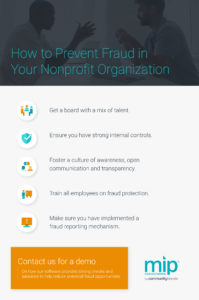At any given time, you can do a Google search for “fraud -embezzlement- nonprofits” and have several news stories come up on how a trusted person has bamboozled funds from a nonprofit. Fraud is always a threat to nonprofit organizations. Tight budgets and staff shortages often contribute to a lack of oversight and prevention measures.
Many nonprofits are based on charity, goodwill, and a genuine need to help others, so often trust is just part of the fabric. This makes nonprofits more vulnerable, and the cost of vulnerability is a high one.
As highlighted in this excerpt from the ACFE’s 2020 Report to the Nations “…nonprofit organizations were the victim in 9% of fraud cases reported by CFEs in the study — with a median loss per instance of $75,000 and an average loss of $639,000. Of these cases, nonprofit employees were more likely to commit fraud (39%), but those at the director and board level tended to steal more ($250,000 compared to $21,000 by employees).”
The impact of a fraud event on a non-profit can include the loss of dollars and loss of donors and loss of reputation.
Fraud in nonprofits can occur in many different ways, including using fake invoices, payroll fraud, embezzlement, misappropriation of funds or company credit cards, fraudulent expense reports and others.
Nonprofits have some unique factors that make you more susceptible to fraud. For instance, if you have a fundraising board who does not have a high degree of financial experience, that can be an opportunity for fraud. Team members wearing too many hats at a nonprofit can be another factor. As a nonprofit organization, sometimes you run lean on staffing. But if you’re putting all the financial responsibilities on one person, you might not have sufficient check and balances built into the nonprofit that are needed for managing funds closely at your nonprofit.
Training is an important component to reducing opportunity for fraud, especially training on regular audit reviewing practices that reduce fraud opportunities. It’s also valuable to maintain training on how to spot potential fraud and become knowledgeable about the new ways to commit fraud that are occurring. Employee turnover can also play a part in fraud because when you have a high employee turnover, you might have more instance of fraud.
Lack of internal controls is also another contributor. One piece of internal control that nonprofits can utilize is doing background checks on any potential employees. Sometimes people who commit fraud will simply move to another nonprofit and do the same thing at the new nonprofit. Strong checks and balances in place from the accounting perspective can also significantly reduce opportunities for fraud.
Why does fraud occur?
Financial pressure. According to researchers, the biggest reason people commit fraud is because they need or want the money. Economic factors can influence someone who was a trusted person to commit fraud. Rationalization is another factor you’ll see, where for instance someone who takes a little cash at a time with the idea they will eventually pay it back. Opportunity is another factor, so putting checks and balances in place make it harder for someone to have the opportunity to commit fraud.
Detecting and preventing fraud – 3 tips internally
- As a nonprofit get a board with a mix of talent on your board so that you will have folks that can serve too as part of your checks/balance team.
- Ensure your internal controls are formally documented, well-understood and strongly enforced. Post them on the walls in your office.
- Foster a culture of awareness, open communication and transparency for employees, donors and stakeholders.
Ensure you train all employees on fraud protection. Make sure you have implemented a fraud reporting mechanism in place so all employees know they can report fraud if they see it. Let them know the impacts of fraud on your mission and your stakeholders.
Monitoring your data
Data. Data. Data. Tracking your data is another valuable way to not only deter fraud, but also to find fraud. Data monitoring, analyzing of data and surprise audits correlate with the largest reductions in fraud loss and duration of loss. Surprisingly, many nonprofits have still not implemented these deterrents as a regular part of their overall fraud deterrent program. Consistent data monitoring in accounts payable and the billing provide a significant overall benefit of fraud reduction.
For instance, in accounts payable look for these red flags:
- Check tampering
- Unfamiliar vendors
- Sudden increases in purchases from one vendor
- Vendors with only a P.O. Box for contact
- Vendor addresses that match employee addresses
In transactions and reimbursements these might be red flags:
- Misclassifications of transactions
- Transactions conducted at unusual times of day or evening, or holidays outside of M-F work hours
- Transactions that are multiple or occurring more frequently or less frequently than expected
On documentation here are red flags:
- Missing or altered documents
- Evidence of backdated documents
- Missing or unavailable originals
- Questionable or missing signatures
Do you have an accounting system that will ensure fraud protection efforts including enabling alerts, masking of sensitive account information in the data, and the ability to set user rights? This is also a key to reducing embezzlement and frauduent activities. The more controls and restrictions you have in place within your software program, the more you will be able to reduce the opportunity to commit it.
MIP is committed to helping reduce fraud and we encourage you to contact us for a demo on how our software provides strong checks and balances to help reduce potential fraud opportunities. . To register for the demo go here .
Other resources:





